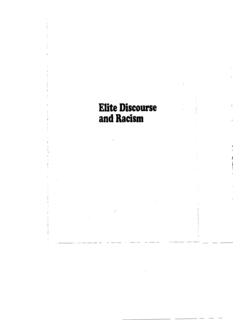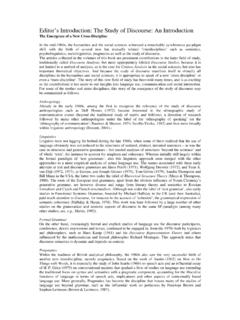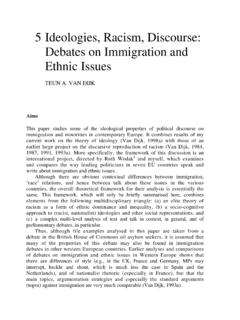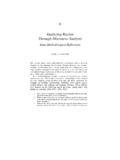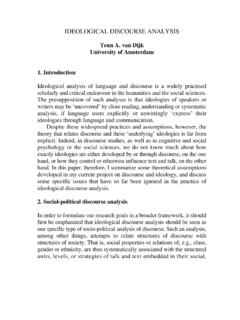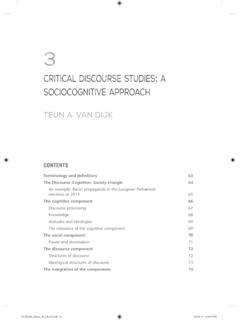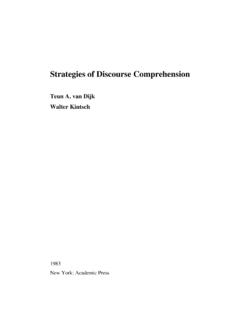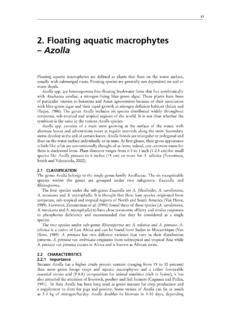Transcription of NEWS ANALYSIS - Teun A. van Dijk
1 news ANALYSIS CASE STUDIES OF INTERNATIONAL AND NATIONAL news IN THE PRESS TEUN A. VAN DIJK University of Amsterdam LAWRENCE ERLBAUM ASSOCIATES, PUBLISHERS 1988 Hillsdale, New Jersey Hove and London COMMUNICATION A series of volumes edited by Dolph Zillmann and Jennings Bryant ZILLMANN AND BRYANT Selective Exposure to Communication BEVILLE Audience Ratings: Radio, Television, and Cable BRYANT AND ZILLMANN Perspectives on Media Effects GOLDSTEIN Reporting Science: The Case of Aggression ELLIS AND DONOHUE Contemporary Issues in Language and Discourse Processes WINETT Information and Behavior: Systems of Influence HUESMANN AND ERON Television and the Aggressive Child.
2 A Cross-National Comparison GUNTER Poor Reception: Misunderstanding and Forgetting Broadcast news OLASKY Corporate Public Relations: A New Historical Perspective DONOHEW, SYPHER, AND HIGGINS Communication, Social Cognition, and Affect VAN DIJK news ANALYSIS : Case Studies of International news in the Press VAN DIJK news as Discourse CONTENTS PREFACE ix ACKNOWLEDGMENTS xiii 1 THE ANALYSIS OF news AS DISCOURSE / news as Discourse 1 The Development of Discourse ANALYSIS 3 Discourse Structures and news Reports 8 Processing news as Discourse 18 2 STRUCTURES OF INTERNATIONAL news 31 International news 31 The Setup of the Case Study 64 Quantitative Results 67 Thematic Structures 72 Schematic Structures 91 Local Semantics 99 Style and Rhetoric 108 y vi CONTENTS Photographs 115 The Use of Agency and Correspondent's Reports 116 Opinions in
3 Editorials and news Articles 124 Conclusions 129 3 RACISM AND THE PRESS 135 Introduction: Ethnic Groups and Squatters in the Media 135 Some General Properties of Domestic news 139 news in the Dutch Press: General Data 144 Mass Media and the Reproduction of Racism 149 Properties of news About Ethnic Minority Groups 161 Processing news About Minorities 200 Contexts and Conclusions 208 4 THE TAMIL PANIC IN THE PRESS 215 Tamils in the Press 216 The Corpus 217 Tamils in the Netherlands: Installments of the Story 218 A Few Descriptive Results 219 The Headlines: Defining the Situation 226 Thematic Structures 230 Schematic Structures 233 Local Semantics and Style 235 Public Opinion 246 Talk About Tamils 247 Television news 248 Conclusions 251 5 SQUATTERS IN THE PRESS 255 Introduction 255 Backgrounds: Housing and Squatting in Amsterdam 256 The Events of October 9, 1981 257 The Role of the Press.
4 Earlier Studies 260 Setup of the Case Study and Some Quantitative Results 262 Thematic Structures 266 Schematic Structures 270 Local Semantics 270 Style 276 Rhetoric 278 Other Media and Messages 283 Conclusions 285 6 CONCLUSIONS 289 CONTENTS vii APPENDLX 295 REFERENCES 303 AUTIIOR INDEX 315 SUBJECT INDEX 321 PREFACE This book presents a series of case studies that illustrate the structures of national and intemational news in the press. it first summarizes our dis-course analytical theory of the processes and structures of news reports as it has been developed in the last five years. Then, this theoretical framework is applied to an ANALYSIS of the structures of intemational news , based on a case study of world press reporting of the assassination of president-elect Bechir Gemayel of Lebanon in September 1982.
5 In this study, which summarizes the result of a longer report written for UNESCO, hundreds of news reports that appeared in more than 260 newspapers from some 100 countries were analyzed and compared. One question addressed in that study is whether newspapers from different countries and regions of the world, and pro-duced in different political and ideological contexts, world also provide equally variable types of description of such a world event. We hope that the answer to this and related questions may contribute to the ongoing debate, stimulated by Third World countries, about the perceived imbalance in intemational news sources, topics, and distribution.
6 This study is embedded in a more general ANALYSIS of possible differences in intemational news coverage among 15 First World and 15 Third World newspapers during three days in September 1982. Although the study of Lebanon has particular relevance for our insight finto world press reporting on a stereotypical news event in a Third World ix x PREFACE country, the other studies focus on marginalized groups in national news reporting ethnic minorities, refugees, and squatters. Data from these studies are based on an ANALYSIS of the Dutch press, but the results and our discussion suggest that they provide a more general picture of the coverage of nondominant groups in Western societies.
7 Thus, parallels can be made between the access and portrayal in the Western press of geographically or ideologically distant Third World nations and actors abroad and the socially distant immigrants or minorities (often of Third World origin) at home. Since most press studies in English deal with the American and the British press, the analyses of Dutch newspapers are also intended to complement this earlier research with insights in the press of another European country. Besides its theoretical and descriptive goals, this book also has a critical dimension. The topics in this study cannot simply be treated in a traditional academic fashion; rather, they have important moral and political implica-tions that need to be spelled out explicitly.
8 In this regard, journalists are considered part of a dominant, cultural elite who often contribute unwit-tingly to the expression and legitimation of the national and international power structures. We try to show how the press, through subtle discursive means, thus reproduces this power. One of the methodological aims of this book is to stimulate a new, more explicit and systematic, approach to the study of mass media discourse in general and to news reporting in particular. Discourse ANALYSIS thus hopes to complement, more qualitatively, the traditional methods of quantitative content ANALYSIS .
9 It allows us to inquire into abstract formal structures of news reports as well as into their subtle underlying meanings, in a way usually ignored in content ANALYSIS . Yet, as long as computer programs cannot take over such precise microanalyses, this method is still limited to small amounts of data. I arge-scale investigations of hundreds or thousands of media texts must still be complemented with a more superficial and more limited type of content ANALYSIS , such as presented in this book. Neverthe-less, we hope that the theoretically more adequate discourse ANALYSIS of news will stimulate a new, more qualitative orientation in the study of mass communication.
10 The first version of this book was written as part of a larger study on news as Discourse, which also contained chapters on the structures, the produc-tion, and the comprehension of news in the press. That study was so large that we divided it into the present, more descriptive book, and another theoretical book on the discourse analytical approach to news processing and mass communication. The latter retained the original title and is pub-lished as a companion volume in this series. For invaluable assistance in the computer processing of the data of the respective case studies, I am particularly indebted to my assistant Piet de Geus.
